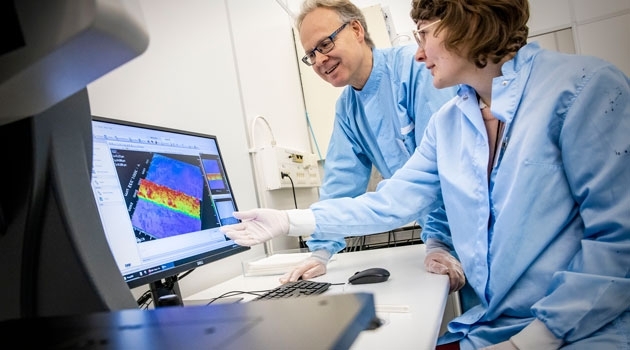Uppsala researchers developing flatworm-inspired robots as part of EU project
The EU project SOMIRO began at the turn of the year with the goal of developing technology that will help to reduce the environmental impact of agriculture. The project is being coordinated by Uppsala University, where researchers are currently developing swimming, flatworm-inspired milli-robots.
Division of Microsystems Technology.
Photo: Mikael Wallerstedt
“These tiny robots are designed to run solely on the energy naturally available in the environment – in this case sunlight,” says Klas Hjort, Project Coordinator and Professor at the Division of Microsystems Technology.
One centimetre long and no more than 20 cubic millimetres in volume: those are the dimensions of the prototype on the screen in the cleanroom at the Ångström Laboratory. It can be difficult to comprehend that the final version of this milli-robot will house both solar cells and wireless sensors – plus a motor. Creating something that is as small as possible but still getting it to communicate and move is, according to Klas Hjort, the big challenge.
“This insect-sized structure has a total power output of 1.5 milliwatts. However, of that just 0.1 milliwatts or 100 microwatts is used for the electronic components for communication, intelligence, and for chemical sensors. The remaining 90 per cent or so of the milli-robot’s energy is used to run the motor.”
Recharged from solar cells
Nevertheless, the milli-robot will require far less energy to move around than other robots of a comparable size, as it will recharge from natural sunlight. Instead of being fitted with an unwieldy battery, the milli-robot will run on flexible solar cells no more than 10 micrometres thick, which is just a fraction of the diameter of a human hair.
“To capture energy from the sun, the milli-robot needs to have the greatest possible surface area,” Klas Hjort explains. “But it must also be soft and flexible as this means it will need very little energy to move. A swimming flatworm is the ideal model as it fulfils all three of these requirements.”
The idea is that the flatworm-inspired milli-robot will be able to move by itself across a large area, floating on the surface of the water. Work to develop and test the robot, initially in the lab and later in the field, is being shared by nine partners from six European countries. The SOMIRO project (an acronym for soft milli-robot), has a budget of approximately SEK 30 million over three years.
Can reveal environmental impact
The goal is to be able to use the technology for environmental analyses of crops grown in water such as rice or various types of liquid-based animal husbandry such as in aquaponic farms. In these contexts, the milli-robot will be able to measure chemical concentrations and map the carbon footprint, eutrophication and the overuse of pesticides and feed.
“With ten milli-robots, we can easily cover around two hundred square metres and get a clear understanding of, for example, how much fertiliser or arsenic there is in a rice field. The robot’s sensor systems mean that it can independently seek out those places that are the most interesting for taking measurements, thereby helping to make agricultural practices as good and sustainable as they can be,” says Klas Hjort.
However, the Uppsala researchers’ part of the project is not expected to lead to any kind of product. According to Klas Hjort, each step in the project is of strategic relevance and entails a high degree of innovation. If they were to achieve excellent results for two or three of the technologies included in the project, that would be a success in itself.
Advanced stretchable printed circuit board technology
Another participant in the project from Sweden along with Uppsala University is the Swedish company Mycronic AB. The partnership between the pair has resulted in a digital printed circuit board (PCB) technology for soft and stretchable smart plasters. They will now be working together to further develop Mycronic’s PCB technology, in order to create the body of the robot and mount all the components onto it. Additionally, there is equipment required by the microsystem researchers at the national cleanroom infrastructure Myfab Uppsala, at the Ångström Laboratory.
“Until now, no milli-robot has ever been produced with local intelligence that is capable of hours of continuous operation without a constant supply of energy from infrastructure. But we have set the bar even higher: our goal is for this robot to operate autonomously for a full month,” says Klas Hjort.
Eventually, he believes that each robot could cost no more than a few hundred Swedish kronor, which would make them accessible to local farms and farmers in developing countries.
“If we can create milli-robots, then we can change society. We haven’t been able to do it so far because too much energy was required in proportion to the size of the robot itself. If we can prove that it is possible, we will be opening up an entire new chapter in the field of robotics.”
Anneli Björkman
Facts: SOMIRO
The three-year Horizon 2020 SOMIRO project has a budget of approximately SEK 30 million and brings together nine participants from six countries: Sweden, Germany, Switzerland, Austria, Spain and Italy. Another participant in the project from Sweden along with Uppsala University is the Swedish company Mycronic AB. Eight people at the Division of Microsystem Technology at Uppsala University are involved in the project, which is being coordinated by Professor Klas Hjort.

